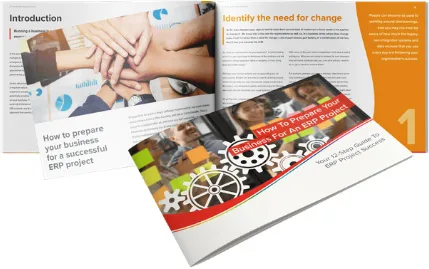ERP solutions streamline manufacturing operations, balancing standard functionality with essential customisation. While out-of-the-box features enable faster deployment and cost savings, customisation supports unique workflows and business growth. However, excessive modifications can increase costs and maintenance challenges. The key is partnering with ERP experts to optimise functionality without unnecessary complexity.
Customer Focussed Manufacturing
Understanding and Catering to the Needs of Your Manufacturing Customers
In the manufacturing sector, what your customers need and what you deliver must be closely aligned. But to be truly successful and grow your business, you have to not only meet those customer needs, but go above and beyond where possible.
Providing the best possible customer experience, standing out from your competitors and building customer loyalty involves recognising what your customers want from you and then translating this into a visible improvement in your operations and what you deliver to your customer base.
Let’s take a look at some of our top tips to help you make the most of your relationships with customers and to stay ahead of their needs and requirements.

Communication Forms the Basis of Your Manufacturing Customer Relationships
The first step to understanding the needs of your customers is communication. Before you do anything else, consult with your top orders and get to know what they expect from you and what it is that keeps them coming back, as well as any key pain points and areas of friction that they are experiencing.
This is not an exact science. Many customers will not know exactly what is causing friction or what is preventing them from achieving their aims.
You will apply your own expertise and understanding about your business to the feedback you receive. For example, a customer may say that your manufactured goods are not being delivered on time. You might already know that your goods are being produced on time, in which case you know that there is friction in the connection between your facility and your client.
The information you gain from these consultations with your customers will give you a solid foundation to build on as you craft a positive experience for your clients. It will also give you some early targets to strive for.
Benefits of a Manufacturing ERP System
Communication is a vital part of any positive relationship between a manufacturer and its customers. However, it can only tell you so much. You need a reliable system via which to analyse, store and interpret the data that all of your business processes and customer and supplier interactions generate.
This is where an enterprise resource planning (ERP) system comes into play. In fact, to be more precise, we should talk about an advanced Material Requirements Planning MRP system here — an ERP designed specifically with manufacturing in mind.
An ERP system will help you to realise next-level coordination between the different departments in your business. It will also have all of your process data and customer data together in one convenient location. From here, your relationship nurturing efforts can really kick into gear as you work to understand any bottlenecks in processes and scrutinise your individual accounts to understand the unique needs of each of your customers, with all of the relevant data at your fingertips.
Using ERP Data to Better Anticipate Manufacturing Customer Needs
With data fully integrated within your ERP software, you will be able to use this solution as production planning software so that you can properly forecast your production schedule and meet the needs of your customers.
Let’s say you onboard a new customer. They are using the products you manufacture in a similar way to one of your other existing customers, but it appears that their needs will require an even greater volume. You already have the process data from your work with your existing client, and so you know how long certain batches take to produce, how long it takes to source new materials, and what might cause friction during the process.
With your manufacturing-specific ERP solution in place, you can scale up this data to produce an accurate forecast for your new customer. You can also draw upon previous data to make the process all the more efficient and effective. Remember, understanding and then meeting your clients’ needs and expectations does not mean waiting for these needs to become problems or for points of friction to grow into serious issues. The best way is to draw upon the data at your disposal — collected from all aspects of your business — and recognise these needs ahead of time.
Establish key client-based metrics
With data at hand, and with the right software in place to handle this data, you need to set yourself and your business key objectives for improvement. Meeting the needs of clients is about consistently working to improve your business and what you offer to your customer base. This improvement cannot be achieved if you do not know what you are aiming for.
Perhaps in the past you have experienced a problem with damaged stock at the point of delivery. The damaged items had to be returned to your facility at a rate of five per cent, increasing your operating costs while damaging the relationship you have with your customer. If this is the case, you might decide to apply the data you have developed within the production planning solution as you seek to improve the supply chain and reduce damage and wastage. But what tangible result are you aiming for? Well, you may decide to set yourself a target of only two per cent returned stock — this provides a clear milestone to aim for.
Applying these types of insights and setting metrics across the various aspects of your business, and being able to clearly and accurately measure the results using the data in your ERP solution, should ultimately lead to continuous improvement.
Bring the Internet of Things (IoT) online
There is always more data out there, and a powerful ERP solution will give you the capability to manage and derive insight from datasets even at great volumes.
In order to push this insight and understanding to optimal levels, many contemporary manufacturers are bringing the Internet of Things ( IoT) online in their factories and warehouses. Your manufacturing equipment, as well as your supply chain, is a veritable gold mine of knowledge. Deploying smart sensors and other pieces of IoT-enabled kit will enable you to gain data directly from the machinery itself, giving you an almost real-time view of what is going on within your facility.
There are many great leaps happening in this area all of the time. Check out this fantastic article on Epicor Shop Floor about what you need to know about the Industrial Internet of things (IIOT).
The Wrap
Bear in mind that truly understanding your customers’ needs and delivering that and more is an ongoing process. To be successful, you will need to adopt a business-wide culture of client-centred processes, data literacy and continual pursuit of excellence in terms of the customer experience.
With the right approach, the right business software solutions, and the right experience partner assisting you, this is not so difficult to achieve. Let us help you uncover the challenge areas in your business and identify ways you can improve your operations and ultimately your customer experience. Book a 15-minute informal discussion with one of our manufacturing ERP solution experts today.
Related Articles
Epicor ARM 2024.2.2 Released
Unlock smarter procurement with Epicor ARM 2024.2.2! From flexible approval workflows to seamless invoice matching, this release is packed with customer-focused improvements to boost efficiency and control. Discover how the latest Epicor ARM enhancements can streamline your procurement and AP management, making it smarter, faster, and more efficient!
Unlock Seamless UI Testing with Kinetic’s Test ReCoder Tool
Kinetic customers can now harness the power of the Test ReCoder UI Test Tool to set their QA processes on a smarter, faster track! This core enhancement in the latest Kinetic release (2024.2) is loaded with benefits including reduced test execution time, lower error rates, and enhanced productivity.
Epicor Kinetic’s Answer to SQL Bottlenecks
Epicor Kinetic’s SQL to BAQ Generator simplifies data analytics and streamlines workflows by converting SQL queries into intuitive, easy-to-use BAQs.
What unique features does the Epicor Kinetic ERP system offer for manufacturing businesses?
Manufacturing businesses face complex challenges that require tailored solutions. Epicor manufacturing ERP software stands out by offering features designed to meet the unique needs of the manufacturing sector. In this blog, we will explore the standout features of Epicor Kinetic ERP and how they benefit manufacturers.
Can Epicor Kinetic ERP Adapt to the Evolving Needs of my Business?
Every business experiences growth and change, and it’s important that the tools you use can adapt to these shifts. One of the most versatile solutions available is Epicor Kinetic ERP, designed to support businesses as they evolve.


